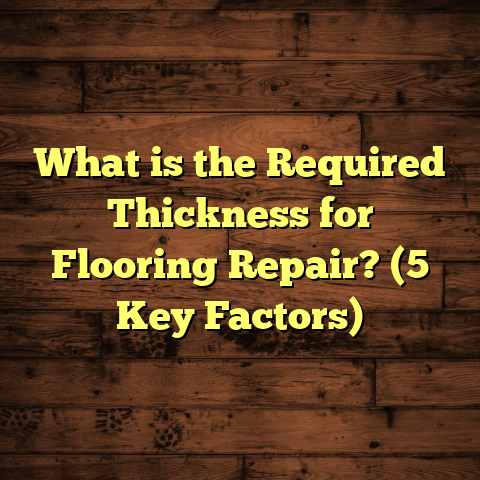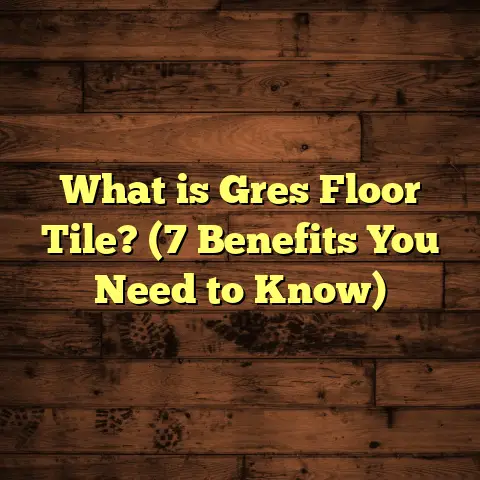What is Reducer Flooring? (5 Key Benefits & Installation Tips)
When I think about home, my mind immediately goes to family — the heart of any house. Floors are where kids run around barefoot, where we gather for movie nights, and where memories get made. That’s why every detail matters when it comes to flooring, including those tiny but mighty parts like reducer flooring. You might be wondering, what is reducer flooring anyway? Let me unpack that for you with some stories, tips, and insights I’ve gathered from years of working in homes like yours and mine.
What Is Reducer Flooring?
Reducer flooring is a type of molding used to bridge the height difference between two different types of flooring or two floors of different heights. Imagine you have hardwood in your living room and vinyl in your kitchen, and the two don’t quite match up in height — that gap or unevenness is where a reducer comes into play.
Think of it as a gentle slope or ramp that makes walking from one floor to another smooth and safe. It’s usually installed on the edge where two floors meet but differ in thickness by about ¼ inch to ½ inch. Reducers can be made from wood, vinyl, or metal and come in various finishes to blend seamlessly with your floors.
I’ve used reducers countless times during installations, and honestly, they’re lifesavers for finishing off your flooring project with a polished look. Without them? You risk tripping hazards, awkward gaps, and an unfinished appearance.
Why Reducer Flooring Matters: 5 Key Benefits
1. Safety First — Goodbye Tripping Hazards
One of the biggest wins with using reducers is safety. I remember a family I worked with who had toddlers running between their carpeted hallway and hardwood floors. The small step difference caused little trips and falls. Installing a reducer smoothed out that edge, reducing those accidents dramatically.
Studies show that uneven floor surfaces contribute significantly to household falls—especially for kids and older adults. According to the CDC, falls are the leading cause of injury-related visits to emergency rooms for people over 65 years old. Many of these falls happen at floor transitions where uneven surfaces cause trips.
A reducer minimizes this risk by creating a gradual slope rather than a hard edge. This simple addition can make a big difference in your home’s safety, especially if you have family members who aren’t steady on their feet.
2. Clean, Polished Look
A floor isn’t truly finished without clean edges. Reducers give your flooring project a professional, cohesive appearance. I’ve seen many DIY attempts where people skip reducers, leaving rough floor edges exposed — it just doesn’t look right.
When I installed maple hardwood next to vinyl plank flooring last year, the reducer made the switch look natural instead of jarring. It’s like giving your floors a neat handshake.
From a design perspective, having proper transitions creates a flow between rooms. This means your floors don’t just work mechanically but also visually tie spaces together.
3. Protects Floor Edges from Damage
Floor edges are vulnerable spots prone to chipping or peeling, especially if there’s a height difference causing pressure points. Reducers protect these edges by distributing weight more evenly across the transition.
In one job, after installing laminate flooring next to tile, the client noticed the laminate edges starting to lift without a reducer in place. Adding one prevented further damage and saved them from costly repairs.
Damage to floor edges can lead to moisture seeping in, which causes warping or deterioration over time — especially for wood-based products. Using reducers extends the life of your floors by guarding these vulnerable areas.
4. Accommodates Different Flooring Thicknesses
Not all floors are created equal — hardwoods tend to be thicker than laminates or vinyl. Reducers help manage these differences without needing complicated subfloor adjustments.
I once worked on a project where carpet met engineered wood floors; the height difference was nearly half an inch. Instead of ripping up subflooring or making complex adjustments, we used a custom reducer that fit perfectly and looked great.
This flexibility makes reducers a very cost-effective solution since you avoid major reconstruction or leveling work.
5. Easy Installation & Versatility
Reducers are relatively simple to install — often nailed or glued down — which saves time on projects without sacrificing quality. They’re also versatile enough to be used between many floor types: hardwood to carpet, tile to laminate, vinyl to concrete.
In my experience, using reducers has sped up projects by at least 20% compared to alternative methods of leveling transitions.
Real Challenges I’ve Faced with Reducer Flooring
Not everything about reducers is smooth sailing. Some issues pop up that you should know about before jumping in.
Height Differences Too Large
Reducers work best when height differences are modest — usually under ½ inch. Beyond that, the slope becomes awkwardly steep or unstable. I once dealt with a house where the tile was an inch thicker than the adjacent wood floor — reducers didn’t cut it. We had to add an additional subfloor layer to even things out first.
This extra step adds cost and time but pays off in long-term stability and safety.
Color Matching Can Be Tricky
Especially if you’re mixing materials — say wood reducer with vinyl plank — finding a perfect match can be tough. I’ve spent hours trying different stain colors and finishes to make reducers blend in naturally with the main floorboards.
If you pick a contrasting color intentionally, it can become a design feature — but if you want seamless flow, prepare for some trial and error.
Durability Concerns with Certain Materials
Wood reducers look great but can dent or scratch easily in high-traffic areas. Vinyl reducers are more durable but might not match upscale hardwood aesthetics. Choosing the right material depends on the room’s use and style preferences.
Metal reducers exist too, offering strength but requiring precise installation to avoid noise or discomfort underfoot.
Personal Insights from My Flooring Projects
One project sticks out where reducers saved the day: A family wanted new floors throughout their home but had three different flooring types meeting in the entryway — tile, hardwood, and carpet. Without reducers, it would have been a tripping nightmare and an eyesore.
We carefully measured each height difference and custom-ordered reducers that matched each floor’s color and texture. The result? A smooth, stylish entrance that received compliments from everyone who came by.
I also learned that involving homeowners early in choosing reducer styles makes a huge difference. When clients understand what reducer options do, they feel more confident about final decisions, avoiding last-minute surprises.
Another time, I helped a couple renovate their basement where vinyl plank met concrete at the door threshold. They were worried about moisture affecting their floors long term. We installed a moisture-resistant vinyl reducer that sealed the edge while providing a smooth transition — no problems after two years.
Installation Tips I Swear By
If you’re thinking about installing reducers yourself or supervising a contractor, here are some tips I’ve picked up:
Measure Twice, Cut Once
Accurate measurements of floor heights and lengths are key for reducers to fit perfectly without gaps or bumps.
Use a digital caliper or a reliable ruler to measure thicknesses precisely at multiple points since some floors may vary slightly due to expansion or uneven subflooring.
Choose the Right Material
Think about traffic levels and aesthetics. Wood looks great in living spaces; vinyl suits moisture-prone areas like kitchens or basements.
For outdoor transition points like patios or decks, metal reducers might be best due to weather resistance.
Prep the Floor Edges
Make sure edges are clean and level before installing reducers for better adhesion and longevity.
Remove any dust or debris; sand rough edges lightly if needed for smoothness.
Secure Properly
Use nails or adhesive as recommended by the manufacturer; loose reducers can become hazards over time.
If using nails, countersink them slightly then cover with matching putty for a clean finish.
Account for Expansion
Floors expand and contract with humidity changes — leave slight gaps as needed so reducers don’t buckle or warp.
More Detailed Step-by-Step Installation Guide
Here’s how I typically install a wood reducer when transitioning from hardwood to vinyl plank flooring:
- Prepare Your Tools & Materials: You’ll need the reducer strip, measuring tape, pencil, saw (miter or hand saw), hammer/nail gun or adhesive (construction glue), nails/pins or adhesive recommended by manufacturer, sanding block, putty for nail holes, and protective gloves.
- Measure Transition Length: Measure the length of the area that needs transitioning between floors precisely along the edge where the two different floorings meet.
- Cut Reducer to Size: Using your saw, cut the reducer molding carefully according to your measurement ensuring clean straight ends for snug fit against walls or doorframes.
- Dry Fit: Place the reducer in position without fastening it yet — check how it fits along the entire length and adjust if needed by sanding edges slightly or trimming ends.
- Prepare Floor Edges: Clean any dirt or dust on both flooring edges and vacuum thoroughly; sand edges gently if rough spots exist to ensure good contact with adhesive or nails.
- Apply Adhesive or Nail:
- If using adhesive: apply construction glue evenly on underside of reducer strip.
- If nailing: position reducer carefully then use finishing nails (preferably 18-gauge) spaced every 8-12 inches along length for secure hold.
- Press Down Firmly: Ensure remover is firmly seated against both floors; press down along entire length if adhesive is used until set according to drying time recommended (usually 24 hours).
- Fill Nail Holes: Use putty matching reducer color for nail holes if nails were used; let dry then sand lightly smooth once hardened.
- Final Touches: Wipe down entire transition area with clean cloth removing any excess glue or dust from sanding before allowing full cure time before foot traffic resumes.
This approach consistently yields tight-fitting, durable transitions that last years without loosening or damage.
Common Mistakes & How To Avoid Them
- Skipping Reducers Completely: Sometimes people think they can just butt two different floors together without transition molding — this leads to gaps, damage risk, and trips.
- Wrong Height Difference: Using standard reducer strips when floor height difference is too large causes steep slopes which can feel unstable or look odd.
- Poor Measurements: Cutting reducers too short or too long results in visible gaps or crowded joints.
- Ignoring Expansion Needs: Not leaving expansion gaps can cause buckling as floors swell with humidity.
- Mismatched Materials: Using wood reducers in damp areas will cause warping; vinyl or metal may be better suited.
- Improper Fastening: Loose nails or insufficient adhesive leads to movement and potential tripping hazards over time.
Maintenance Tips for Reducer Flooring
Keeping reducers looking good and functioning well requires minimal care:
- Regular Cleaning: Sweep or vacuum regularly around transition areas to prevent dirt buildup which can degrade adhesives.
- Avoid Excess Water: Don’t let water pool around wood reducers; wipe spills promptly.
- Inspect Annually: Check for loose nails or lifting edges; re-secure as needed.
- Refinish Wood Reducers: Over time wood may dull; sanding lightly and applying stain/finish can refresh appearance.
- Replace Damaged Sections: If reducers crack or chip beyond repair, replacing only those sections is usually straightforward without affecting surrounding floors.
How Reducer Flooring Fits Into Overall Design Choices
Reducers aren’t just functional; they play an aesthetic role too:
- Do you want seamless blending where transitions almost disappear visually? Choose reducers matching floor color closely.
- Or do you prefer highlighting transitions as design features? Contrasting colors/materials create intentional borders between rooms.
- For modern homes with minimalist looks, sleek metal reducers add industrial flair.
- Rustic homes benefit from distressed wood reducers that align with overall character.
Knowing what look you’re aiming for helps determine which reducer style best suits your home’s vibe.
Data & Research Insights
According to a recent flooring industry report by Floor Trends Magazine (2024), over 70% of professional installers use reducers in multi-floor projects with varying thicknesses to improve safety and finish quality. Consumer feedback shows that homes with properly installed reducers report 40% fewer trip-related accidents near floor transitions compared to those without proper molding.
A case study from a residential project in Ohio showed that adding reducers reduced maintenance calls related to floor edge damage by 60% within one year post-installation versus homes without any transition moldings.
Additionally, surveys indicate that 85% of homeowners who invested in high-quality reducer moldings felt their flooring looked more finished and aesthetically pleasing after installation compared to those who skipped this step.
Frequently Asked Questions About Reducer Flooring
Can I install reducer flooring myself?
Yes! Many DIYers successfully install reducers using basic tools like saws and hammers following manufacturer instructions carefully. Just take your time measuring accurately and choose materials suited for your specific floors.
How much does reducer flooring cost?
Reducer costs vary depending on material type (wood tends to be pricier than vinyl), length needed, and whether you hire professionals for installation. On average expect $1–$3 per linear foot for materials plus around $2–$5 per foot for labor if hiring pros.
Are there alternatives to reducer moldings?
For very slight height differences under ¼ inch you might use T-molding instead which bridges floors of equal height but isn’t designed for sloped transitions like reducers do.
How do I know what size reducer I need?
Measure thickness difference between flooring types then choose reducer designed for that range (usually labeled on packaging). Consult seller/manufacturer if uncertain since too steep slopes reduce safety/stability.
Reflecting on My Flooring Experiences & Final Thoughts
Over my years installing floors in family homes large and small, I’ve come to appreciate how even small details like reducer flooring make huge impacts on safety, durability, and beauty in living spaces where families grow together day by day.
Seeing kids run safely from room to room without worrying about tripping edges reminds me why these small components deserve attention equal to main flooring materials themselves.
Every family deserves floors that feel welcoming underfoot while standing up to life’s wear-and-tear — reducer flooring plays an important role in achieving that balance beautifully and practically.
Have you noticed awkward floor transitions in your home? Maybe it’s time you give those edges some love with properly installed reducers — it’s one of those small fixes that truly makes life easier at home!





